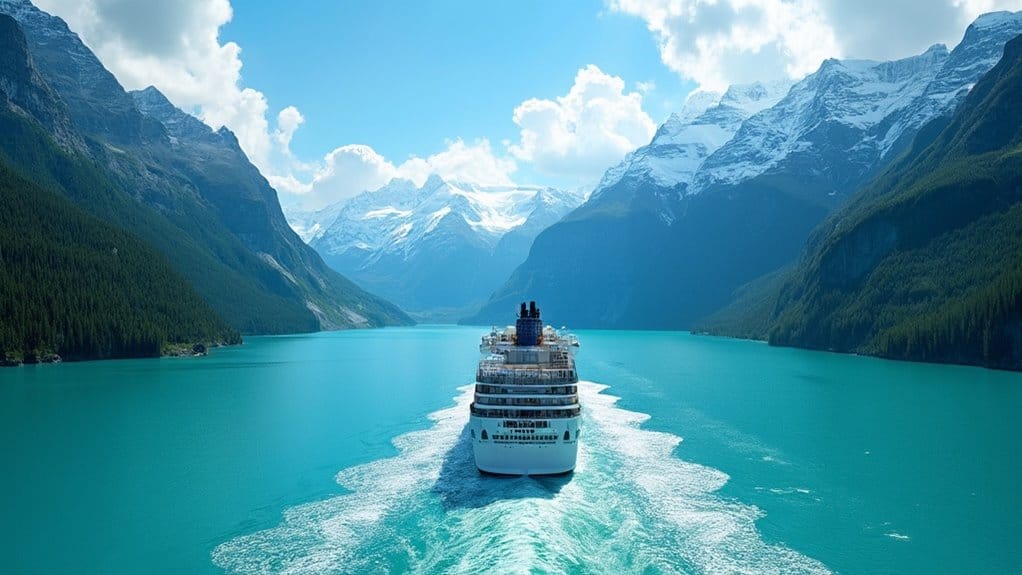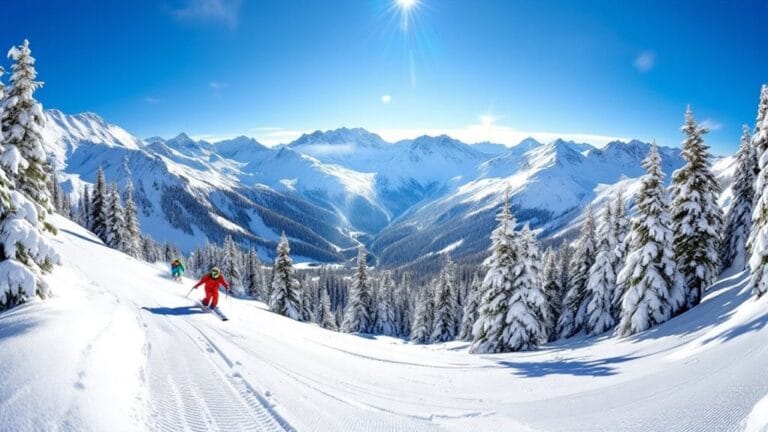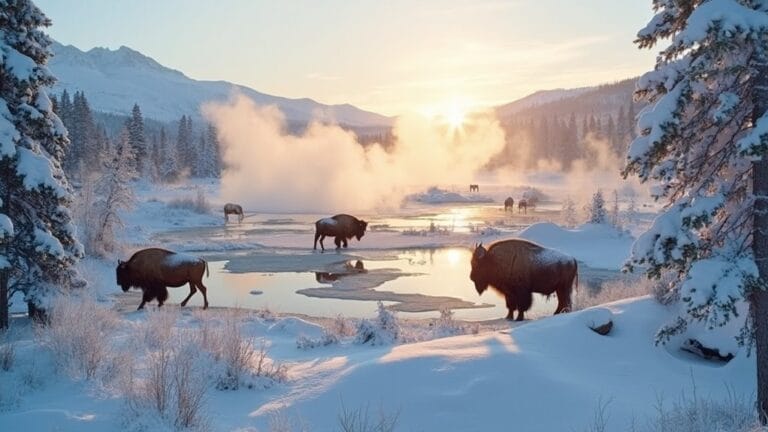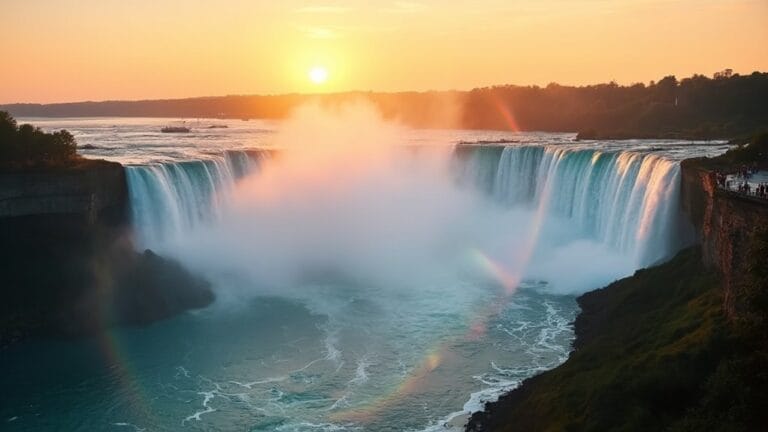When’s the best time to cruise Alaska? If you want the warmest weather and brightest days, late June to August is prime time. Think sunny 70s and up to 18 hours of daylight! July’s perfect for spotting grizzly bears and majestic whales, creating memories you’ll cherish. But if it’s fewer crowds and better prices you seek, try May or September with cooler temps and stunning fall colors. Want to catch the magical Northern Lights? September’s got you covered! No matter when you go, pack layers so you’re ready for anything Mother Nature throws your way. For insider tips, stick around!
Key Takeaways
- Peak Season (June to August) offers warm weather, long daylight hours, and excellent wildlife viewing opportunities, but comes with higher prices and crowds.
- Shoulder Season (May and September) provides cooler temperatures, fewer tourists, and lower prices, making it a budget-friendly option.
- Wildlife Activity is Highest in July, with grizzly bears and humpback whales prominently visible, enhancing the cruising experience.
- April and October are Off-Season, featuring limited services, but unique experiences like winter tracking or Northern Lights in September.
- Packing a Mix of Clothing is essential due to variable weather; layers help prepare for both warm days and cooler evenings.
Overview of Cruise Seasons
When planning your Alaska cruise, it is essential to understand the different cruise seasons, as they can greatly impact your experience. Think about it: if you’re dreaming of warm, sunny days, peak season from late June to August is your best bet. With about 18 hours of daylight, you’ll have plenty of time to soak in the breathtaking scenery and enjoy a variety of seasonal activities. That’s when wildlife viewing is at its prime, and trust me, seeing a bear or whale up close is unforgettable! Additionally, the peak season features the warmest weather, making it ideal for outdoor activities and exploration.
Now, if you’re looking for a quieter experience, consider the shoulder season in May or September. You’ll find cooler weather and fewer crowds, with lower prices on cruise itineraries. Plus, late May is fantastic for spotting wildlife mothers with their calves! You might even catch a glimpse of the Northern Lights in September, which is a magical sight.
Just remember, during the off-season, many local services shut down, and options are limited. But if you’re up for unique experiences, like seeing the remnants of winter in April or the charm of Alaskan towns in October, it could be worth it!
Monthly Weather Breakdown
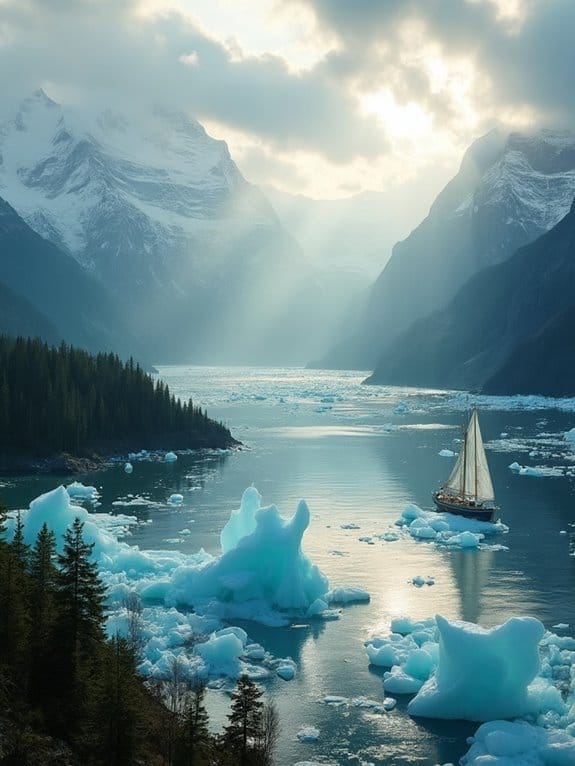
Alaska’s weather can be quite the surprise, especially if you’re cruising during the shoulder seasons. In April and May, you’ll find cooler temperatures, typically hanging around the 40s to 50s, but don’t be shocked if the sun decides to warm things up to the 70s. This unpredictability means you’ll need to master the art of weather preparation—think layers! You’ll want to pack your cruise attire wisely, with a mix of warm and lighter clothing, so you’re ready for anything.
From June to mid-August, the weather is at its best, with highs in the low 60s to low 70s and up to 18 hours of daylight! It’s peak season, so expect crowds and higher prices, but hey, the wildlife activity peaks in July, making it an ideal time for spotting grizzly bears and humpback whales.
As August rolls into September, the temperatures drop again, and you might need that extra layer once more. While the prices dip and crowds thin out, be ready for some unpredictable weather. Just imagine sipping hot cocoa while gazing at the Northern Lights—now that’s what I call a memorable cruise! So, pack smart and prepare for a fantastic adventure!
Wildlife Viewing Opportunities
A wildlife cruise in Alaska offers an unforgettable chance to witness nature’s wonders up close. Envision this: as spring wildlife awakens, you’ll spot bears emerging from their dens and caribou heading to calving areas. The thrill of watching migratory songbirds fill the air in May is something you won’t want to miss! During this time, you may also encounter Dall sheep on the mountainsides, particularly pregnant females, offering a unique glimpse into their lives.
As summer rolls in, it’s prime time for summer migration. You’ll find bears fishing along salmon streams while seabird colonies burst with life. July is especially magical, with fur seal pups and playful walruses basking on islands. And don’t forget the whales—humpbacks and orcas are out in full force, putting on a show.
When fall arrives, the scene shifts to fall rutting. Moose and caribou are strutting their stuff, while bears are busy fattening up for winter. You might even catch a glimpse of gray whales migrating along the coast, a breathtaking sight!
Finally, winter tracking becomes your best friend. With snow blanketing the ground, spotting wolves, lynx, and the world’s largest bald eagle concentration is easier than ever. Each season brings its own unique experiences, making every cruise a thrilling adventure!
Daylight Hours and Phenomena
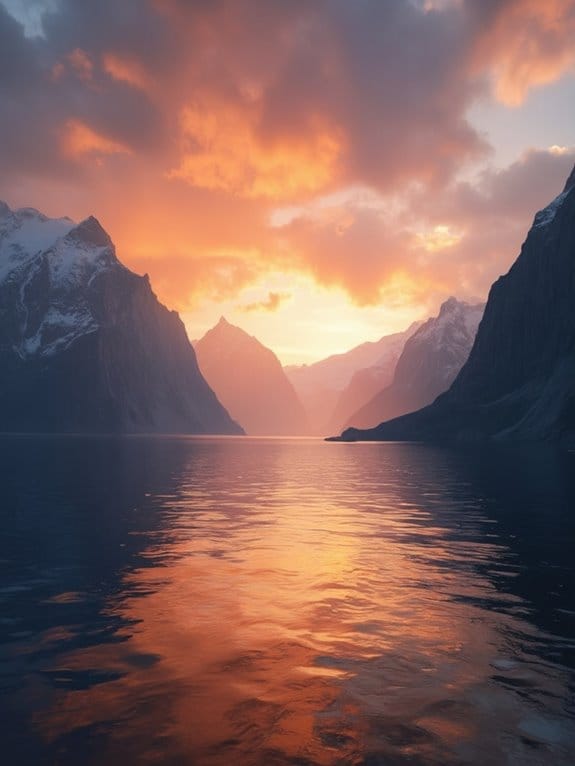
During the summer months, daylight hours in Alaska can be extraordinary, providing a unique experience for visitors. Imagine standing in Barrow, where you can witness 24 hours of daylight during the summer solstice on June 21! It’s wild—at midnight, the sun still hangs in the sky, creating that magical midnight sun effect. In Anchorage, you’ve got about 22 hours of daylight, which means your adventures don’t have to stop just because the clock strikes 8 PM.
From late May to late July, the long daylight hours let you explore nature like never before. Hiking and biking? You can keep going long after dinner, soaking in every last ray of sunshine. Plus, events like the Solstice Festival and the Mayor’s Midnight Sun Marathon make the most of the endless light. The extended daylight also promotes rapid plant growth, transforming Alaska into a vibrant green landscape during summer.
And don’t forget about civil twilight! In Juneau, for example, this begins around 4:11 AM and lasts until 9:36 PM, making those early mornings and late nights feel even more magical. So, pack your bags and get ready to embrace the unique light phenomena that Alaska has to offer. You won’t regret it!
Pricing Trends and Availability

As you’re planning your Alaska cruise adventure, understanding pricing trends and availability can help you make the most of your budget. Prices can soar during peak season, which runs from June to August, thanks to the flood of enthusiastic travelers. But here’s a tip: if you can swing it, consider sailing in the shoulder seasons of May or September. You might enjoy up to a 40% dip in prices, which is music to any budget-conscious traveler’s ears!
The competitive landscape among cruise lines is fierce, with Norwegian Joy offering starting prices around $599, pushing others to keep their rates attractive. Just remember, premium itineraries, like those to Glacier Bay, come with a 20% price hike, so plan accordingly! Additionally, booking in advance typically yields better deals for shoulder season sailings, making it an ideal strategy for savvy travelers.
Availability is also on the rise, with more cruise lines offering longer itineraries to cater to diverse traveler preferences. You’ll find a range of cabin options, from budget-friendly inside cabins to luxurious suites, and don’t forget those package deals that bundle airfare. With 1.65 million passengers hitting Juneau in 2023, it’s clear Alaska’s calling—are you ready to answer?
Frequently Asked Questions
What Should I Pack for an Alaska Cruise?
For your Alaska cruise, pack essentials like waterproof jackets and warm layers. Use layering strategies to adapt to changing weather, and don’t forget comfortable footwear and outdoor gear for excursions and evenings out.
Are There Any Health Precautions to Consider Before Cruising?
Before cruising, consider vaccination requirements and travel insurance. It’s crucial to wash your hands frequently, stay hydrated, and pack necessary medications. Keeping these health precautions in mind will help guarantee a smooth journey ahead.
What Activities Are Available During the Cruise?
During your cruise, you can enjoy wildlife excursions like whale watching and bear spotting. Plus, there’s onboard entertainment with cultural performances and educational talks, making your journey both adventurous and enriching.
Can I Bring My Own Food on Board?
You might think bringing your favorite snacks is impossible, but you can! Prepackaged foods are allowed onboard, though food restrictions apply. Enjoying diverse onboard dining makes your cruise experience even more delightful without compromising your cravings.
How Can I Prepare for Seasickness?
To prepare for seasickness, consider motion sickness tips like staying hydrated, eating lightly, and avoiding strong odors. Seasickness remedies like ginger candies and acupressure bands can also help you manage symptoms effectively.

